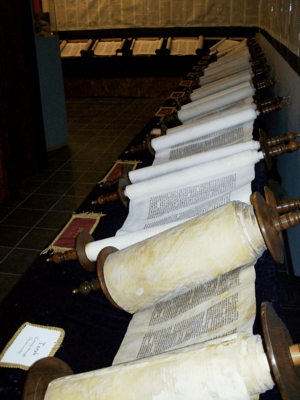Tanakh facts for kids
| Part of a series on | |||
|---|---|---|---|
|
|||
| Judaism | |||
| Category | |||
| Jewish religious movements | |||
| Orthodox (Haredi • Hasidic • Modern) | |||
| Conservative • Reform | |||
| Reconstructionist • Renewal • Humanistic | |||
| Jewish philosophy | |||
| Principles of faith • Kabbalah • Messiah • Ethics | |||
| Chosenness • Names of God • Musar | |||
| Religious texts | |||
| Tanakh (Torah • Nevi'im • Ketuvim) | |||
| Ḥumash • Siddur • Piyutim • Zohar | |||
| Rabbinic literature (Talmud • Midrash • Tosefta) | |||
| Religious Law | |||
| Mishneh Torah • Tur | |||
| Shulchan Aruch • Mishnah Berurah | |||
| Kashrut • Tzniut • Tzedakah • Niddah • Noahide laws | |||
| Holy cities | |||
| Jerusalem • Safed • Hebron • Tiberias | |||
| Important figures | |||
| Abraham • Isaac • Jacob | |||
| Moses • Aaron • David • Solomon | |||
| Sarah • Rebecca • Rachel • Leah | |||
| Rabbinic sages | |||
| Jewish life cycle | |||
| Brit • Pidyon haben • Bar/Bat Mitzvah | |||
| Marriage • Bereavement | |||
| Religious roles | |||
| Rabbi • Rebbe • Posek • Hazzan/Cantor | |||
| Dayan • Rosh yeshiva • Mohel • Kohen/Priest | |||
| Religious buildings & institutions | |||
| Synagogue • Beth midrash • Mikveh | |||
| Sukkah • Chevra kadisha | |||
| Holy Temple / Tabernacle | |||
| Jewish education | |||
| Yeshiva • Kollel • Cheder | |||
| Religious articles | |||
| Sefer Torah • Tallit • Tefillin • Tzitzit • Kippah | |||
| Mezuzah • Hanukiah/Menorah • Shofar | |||
| 4 Species • Kittel • Gartel | |||
| Jewish prayers and services | |||
| Shema • Amidah • Aleinu • Kaddish • Minyan | |||
| Birkat Hamazon • Shehecheyanu • Hallel | |||
| Havdalah • Tachanun • Kol Nidre • Selichot | |||
| Judaism & other religions | |||
| Christianity • Islam • Judeo-Christian | |||
| Abrahamic faiths | |||
| Related topics | |||
| Antisemitism • The Holocaust • Israel • Zionism | |||
The Tanakh is a special collection of books that Jewish people consider holy. It's also known as the Hebrew Bible. Many of the stories and teachings in the Tanakh are also found in the Christian Old Testament. The word "Tanakh" is a short way of saying the names of its three main parts.
Contents
What is the Tanakh?
The Tanakh is made up of three main sections. Each section has different types of books, from laws and history to poetry and prophecies. The name "Tanakh" comes from the first Hebrew letter of each of these three sections.
The Torah
The first part of the Tanakh is called the Torah. This Hebrew word means "law" or "teaching." The Torah is also known as the Pentateuch, which means "five books." It is believed that Moses wrote these five books.
- Genesis: This book tells the story of how the world was created. It also shares stories about early people and the beginnings of the Jewish people.
- Exodus: This book describes how the ancient Israelites escaped from slavery in Egypt. It also tells about Moses receiving the Ten Commandments from God.
- Leviticus: This book contains many laws and rules for the Israelites. It explains how they should live and worship.
- Numbers: This book tells about the Israelites' journey through the desert. It also counts the people in their tribes.
- Deuteronomy: This book repeats many of the laws from earlier books. It also includes Moses' final speeches to the Israelites before they entered the land of Canaan.
The Nevi'im
The second part of the Tanakh is called the Nevi'im. This Hebrew word means "prophets." These books tell the stories of important prophets who guided the Jewish people. They also share messages from God.
- Books like Joshua and Judges tell about the early history of the Israelites in their land.
- Samuel and Kings describe the lives of kings and the history of the kingdoms of Israel.
- Other books, such as Isaiah, Jeremiah, and Ezekiel, contain the words and warnings of major prophets.
- There are also "minor prophets" whose books are shorter but still important.
The Ketuvim
The third section of the Tanakh is called the Ketuvim. This Hebrew word means "writings." This part includes a variety of books that are not considered part of the Torah or the Prophets.
- The Psalms are a collection of beautiful songs and prayers.
- Proverbs offers wise sayings and advice for living a good life.
- The Book of Job explores questions about suffering and faith.
- Other books in the Ketuvim include historical accounts, love poems, and philosophical writings.
Different Names for the Tanakh
The word "Tanakh" is sometimes spelled in different ways in English. You might see it as TANAKH, TaNaKh, tenakh, tanach, or tenak. No matter how it's spelled, it always refers to the same important collection of books.
See also
 In Spanish: Biblia hebrea para niños
In Spanish: Biblia hebrea para niños




